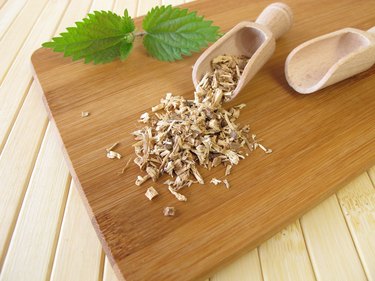
Nettle is commonly known as stinging nettle because of the fine hairs on its leaves and stems that can cause skin irritation. The plant is very nutritious, and nettles have been eaten or used for hundreds of years as a treatment for painful joints and muscles, gout and anemia. Generally, nettle root is not recommended separately from the whole plant. Although nettle contains iron and may be beneficial for treating anemia, it should not be used in place of accepted medicine.
The Plant
Video of the Day
Stinging nettle, also called garden nettle, is native to Europe, Asia and North America. The plant’s botanical name is Urtica dioica. The herb is a perennial that can grow 6 feet tall and is usually found in nitrogen-rich soil along stream banks or in fields. The plant is covered with small hairs that release formic acid, a liquid that can cause inflammation that can last up to 12 hours. If you are going to grow or collect nettle for your own use, wear pants, a long-sleeved shirt and gloves to protect yourself from the painful sting.
Video of the Day
Iron Deficiency
Iron is necessary for good health, because it is used in many of the body’s metabolic processes. Iron is most important in the formation of hemoglobin, a protein that carries oxygen to every cell of the body. People who do not consume enough iron are at risk of developing iron deficiency, which can lead to anemia. Symptoms of anemia are fatigue and weakness, difficulty concentrating, problems maintaining body temperature and a suppressed immune system.
Iron Content
Bastyr University, a natural-medicine education center in Washington state, notes that nettle is a nutritious food that has vitamins and minerals, including iron, potassium and silica. Nettle also contains pro-vitamin A, the vitamin B complex, vitamin K1 and vitamin C, which can help the body absorb the iron and other minerals found in the plant. Both the leaves and the roots of the plant have long been used in herbal medicine, according to the nutritional-education website Herbs 2000, and nettle has frequently been used to make tonics to treat weakness and anemia symptoms.
Cooking Nettle
Nettle can be cooked and eaten as a vegetable. The leaves cannot be eaten raw because of the stinging hairs, but cooking the nettle makes it edible. Some people grow their own nettle, but the plant can be harvested from the wild. If you are going to pick nettle, make sure the area you are harvesting from has not been treated with pesticides or herbicides. Riley Woodford, writing for the Alaska Department of Fish and Game, recommends rinsing the plant to remove any dirt or grit before cooking it. He says nettle is delicious and can be lightly steamed or sauteed.
Nettle Tea and Nettle Supplements
Nettle tea and nettle supplements are available for purchase at natural food stores and many other stores that sell vitamins. Nettle tea can be found in bulk or purchased as tea bags and can easily be taken to work or used at home. Because nettle is a natural product, the amount of vitamins and minerals varies. For this reason, many people prefer to take nettle supplements, which are usually capsules that contain powdered nettle in a standardized extract.